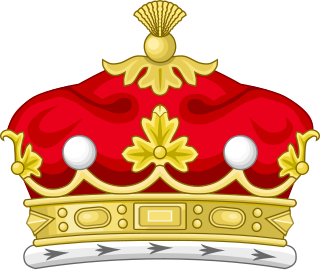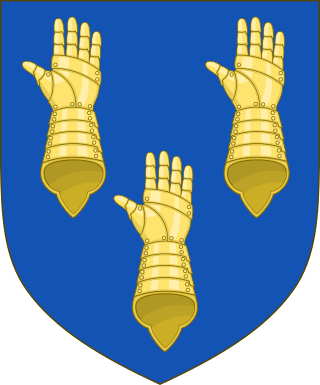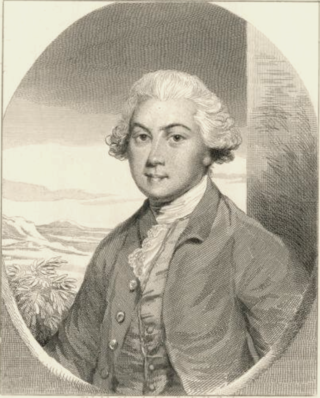Viscount Sydney is a title that has been created twice. The title was elevated twice from a barony, and once into an earldom.

Marquess of Winchester is a title in the Peerage of England that was created in 1551 for the prominent statesman William Paulet, 1st Earl of Wiltshire. It is the oldest of six surviving English marquessates; therefore its holder is considered the premier marquess of England. It is also now the only marquessate in the Peerage of England not being subsidiary to a higher title. The current holder is Christopher Paulet, 19th Marquess of Winchester, whose son uses the courtesy title Earl of Wiltshire.

Earl of Leicester is a title that has been created seven times. The first title was granted during the 12th century in the Peerage of England. The current title is in the Peerage of the United Kingdom and was created in 1837.

Viscount Cobham is a title in the Peerage of Great Britain that was created in 1718. Owing to its special remainder, the title has passed through several families. Since 1889, it has been held by members of the Lyttelton family.

Marquess Townshend is a title in the Peerage of Great Britain held by the Townshend family of Raynham Hall in Norfolk. The title was created in 1787 for George Townshend, 4th Viscount Townshend.

Marquess Conyngham, of the County of Donegal, is a title in the Peerage of Ireland. It was created in 1816 for Henry Conyngham, 1st Earl Conyngham. He was the great-nephew of another Henry Conyngham, 1st Earl Conyngham, a member of a family of Scottish descent which had settled during the Plantation of Ulster in County Donegal in Ireland in the early 17th century. The 'founder' of the dynasty in Ireland was The Very Rev. Dr. Alexander Cunningham, Dean of Raphoe. The earlier Henry was a member of both the Irish House of Commons and the British House of Commons and served as Vice-Admiral of Ulster and as Governor of the counties of Donegal and Londonderry. In 1753 he was raised to the Peerage of Ireland as Baron Conyngham, of Mount Charles in the County of Donegal, and in 1756 he was created Viscount Conyngham, in Ireland, also in the Peerage of Ireland. In 1781 he was made Baron Conyngham, of Mount Charles in the County of Donegal, with remainder to his nephew Francis Burton, and Earl Conyngham, of Mount Charles in the County of Donegal, which like the creations of 1753 and 1756 was created with normal remainder to the heirs male of his body. The latter titles were also in the Peerage of Ireland. Lord Conyngham was childless and on his death in 1781 the barony of 1753, the viscountcy and earldom became extinct while he was succeeded in the barony of 1781 according to the special remainder by his aforementioned nephew Francis. He was the eldest son of Mary, sister of the first Earl Conyngham, by her husband Francis Burton. The new 2nd Baron Conyngham, who had earlier represented Killybegs and County Clare in the Irish House of Commons, assumed by Royal licence the surname and arms of Conyngham on succeeding to the titles.

Baron Barnard, of Barnard Castle in the Bishopric of Durham, is a title in the Peerage of England. It was created in 1698 for Christopher Vane, who had previously served as a member of parliament for County Durham and Boroughbridge. Vane was the son of Sir Henry Vane the Younger and grandson of Sir Henry Vane the Elder. His grandson, the third Baron, notably served as Paymaster of the Forces and as Lord Lieutenant of County Durham. In 1754 he was created Viscount Barnard and Earl of Darlington, both in the County Palatine of Durham. Lord Darlington was the husband of Lady Grace FitzRoy, daughter of Charles FitzRoy, 2nd Duke of Cleveland, the illegitimate son of King Charles II by his mistress Barbara Villiers, 1st Duchess of Cleveland.

Earl of Halifax is a title that has been created four times in British history—once in the Peerage of England, twice in the Peerage of Great Britain, and once in the Peerage of the United Kingdom. The name of the peerage refers to Halifax, West Yorkshire.

Baron Dacre is a title that has been created three times in the Peerage of England, each time by writ.

Viscount Massereene is a title in the Peerage of Ireland. It was created in 1660, along with the subsidiary title of Baron Loughneagh. From 1665 to 1816 the Skeffington Baronetcy of Fisherwick was attached to the viscountcy and from 1756 to 1816 the Viscounts also held the title of Earl of Massereene. Since 1843 the peerages are united with titles of Viscount Ferrard, of Oriel and Baron Oriel, both in the Peerage of Ireland, and Baron Oriel, in the Peerage of the United Kingdom. The Viscount also holds the subsidiary titles of Baron Loughneagh (1660) and Baron Oriel (1790) in the Peerage of Ireland and Baron Oriel (1821) in the Peerage of the United Kingdom. As Baron Oriel, he sat in the House of Lords until 1999.

Lord Nairne is a title in the Peerage of Scotland, created by Charles II for Sir Robert Nairne of Strathord in 1681, which since 1995 is held by the Viscount Mersey.

Baron Southampton, of Southampton in the County of Southampton, is a title in the Peerage of Great Britain. It was created in 1780 for the soldier and politician Charles FitzRoy. He was the third son of Lord Augustus FitzRoy, second son of Charles FitzRoy, 2nd Duke of Grafton, while Prime Minister Augustus FitzRoy, 3rd Duke of Grafton was his elder brother. Lord Southampton was also the great-great-grandson of King Charles II by his mistress Barbara Palmer, 1st Duchess of Cleveland. The Southampton title had previously been created for Charles FitzRoy, eldest natural son of Charles II and the Duchess of Cleveland and the elder brother of Henry FitzRoy, 1st Duke of Grafton, but had become extinct in 1774 on the death of his son William FitzRoy, 3rd Duke of Cleveland and 2nd Duke of Southampton, six years before the creation of the barony of Southampton.

Baron Bolton, of Bolton Castle in the County of York, is a title in the Peerage of Great Britain. It was created in 1797 for the Tory politician Thomas Orde-Powlett, who had previously served as Chief Secretary for Ireland. Born Thomas Orde, he was the husband of Jean Mary Browne-Powlett, illegitimate daughter of Charles Powlett, 5th Duke of Bolton, who had entailed the greater part of his extensive estates to her in default of male issue of his younger brother Harry Powlett, 6th Duke of Bolton.

Viscount Bayning, of Sudbury in the County of Suffolk, was a title in the Peerage of England. It was created on 8 March 1628 for Paul Bayning, 1st Baron Bayning. He had already been created a Baronet, of Bentley Parva in the County of Essex, in the Baronetage of England on 24 September 1611, and Baron Bayning, of Horkesley in the County of Essex, on 27 February 1628, also in the Peerage of England. He was succeeded by his son, the second Viscount. On his early death in 1638, the titles became extinct.

The Honourable William Townshend was a British Member of Parliament.

Charles Townshend, 1st Baron Bayning PC was a British politician.

Charles Frederick Powlett, 2nd Baron Bayning, known as the Honourable Charles Townshend from 1797 to 1810, was a British peer and Tory Member of Parliament.
Henry William-Powlett, 3rd Baron Bayning, styled The Honourable until 1823, was a British peer and clergyman.
Bayning is a surname. Notable people with the surname include:
Paul Bayning, 1st Viscount Bayning of Sudbury in Suffolk, previously known as Sir Paul Bayning and as Baron Bayning, was an English landed gentleman, created a peer in 1628.












